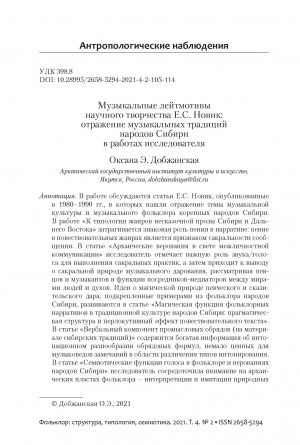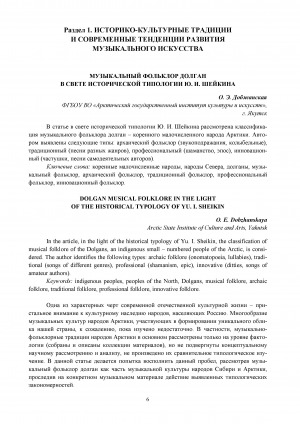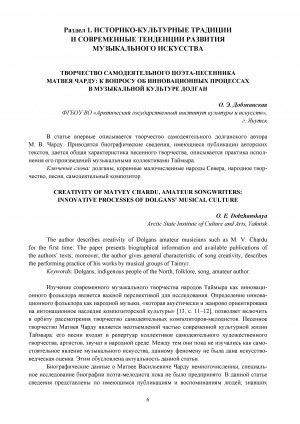Место работы автора, адрес/электронная почта: Арктический государственный институт культуры и искусств, Кафедра искусствоведения ; 677000, г. Якутск, ул. Орджоникидзе, 4 ; e-mail: dobzhanskaya@list.ru ; http://agiki.ru
Ученая степень, ученое звание: д-р искусствоведения
Область научных интересов: Музыкальная фольклористика, музыкальные инструменты народов Арктики, шаманская музыка народов Сибири, традиционное и современное музыкальное творчество народов Таймыра, музыкально-эстетические проблемы в народной художественной культуре
ID Автора: SPIN-код: 1046-0714, РИНЦ AuthorID: 312599
Количество страниц: 8 с.
Добжанская, О. Э. Музыковедческая терминология как зеркало поисков национальной самобытности академического музыкального искусства Республики Саха (Якутия) / О. Э. Добжанская ; Арктический государственный институт культуры и искусств // Термины, понятия и категории в музыковедении : IV Международный конгресс Общества теории музыки, Казань, 2-5 октября 2019 года : материалы конгресса / Министерство культуры Российской Федерации, Казанская государственная консерватория имени Н. Г. Жиганова [и др.] ; редакционная коллегия: Гирфанова М. Е. [и др.]. - Казань : Казанская государственная консерватория, 2021. - С. 205-212.
DOI: 10.48201/9785854012843_205
Источник: SHS Web of Conferences. - 2022, Т. 134.
Количество страниц: 7 с.
Целью данного исследования является изучение звукоиздающих подвесок на шаманском костюме эвенков, якутов и нганасан в единстве шаманского ритуального комплекса и ритуальных музыкальных традиций. Шаманские подвески интерпретируются как особый текст культуры, отражение геокультурных представлений народов Арктики. Статья основана на материалах полевых исследований, проведённых авторами на Таймыре в 1989–1990 годах, в Оленёкском эвенкийском национальном округе Якутии в 2014 году, а также на научных публикациях. Звуковой мир шаманского ритуала — это сложная звуковая картина, которая формируется при использовании вокальных, вербальных, вокально-речевых, сигнальных, инструментальных типов интонации. Движения шамана сопровождаются звуком сталкивающихся подвесок на костюме шамана и его составляющих (повязке, обуви, перчатках).
Звукоиздающие подвески были описаны этнографами и музыковедами, но не рассматривались в связи с геокультурными исследованиями. Металлические подвески на костюме шамана обозначают священные пространственные модели Вселенной (образы небесных тел — солнца, луны, звёзд), мифологические пространства Верхнего, Среднего и Нижнего миров, населённые духами-помощниками шамана — птицами, животными, антропоморфными существами, символизируют части человеческого тела и т. д. Перспективы изучения подвесок на костюме шамана как символического воплощения ландшафта заключаются в более полном описании и обобщении всех известных материалов, включая анализ костюмов шаманов из этнографических музейных коллекций.
Reflection of Arctic geocultures in the sounding attributes of the shaman costumes of Sakha, Evenks and Nganasans / Oksana Dobzanskaya, Vera Nikiforova, Varvara Dyakonova ; Arctic State Institute of Culture and Arts // SHS Web of Conferences. - 2022, Т. 134. - С. 1-7
Количество страниц: 10 с.
This article is dedicated to the discussion on the articles by E. S. Novik, publsihed in 1980–1990s, which reflect the themes of musical cutlure and musical folklore of the indigenous peoples of Siberia . In the article "On the typology of genres of non-fairytale prose of Siberia and the Far East" she touches upon the significant role of singing in the narrative: singing in narrative genres is a sign of a sacred message. In the article "Archaic beliefs in the light of interpersonal communication" the scholar points out the important role of the sound/voice for performing the sacred practices, and then comes to a conclusion about the sacred nature of a musical talent, consindering singers and musicians as the mediators between the worlds of people and spirits. The ideas about the magical nature of the singing and storytelling talents, supported by the examples from the Siberian folklore, are developed further in the article "The magical function of folklore narratives in the traditional culture of the peoples of Siberia: pragmatic structure and perlocutionary effect of thenarrative text". In the article "The verbal component of the hunting and fishing rituals (based on materials of the Siberian traditions)" one can findplenty of data on the intonational diversity of the ritualistic formulae, as well as the solid number of the notes, concerning the distinguishment of the different types of intonation, which might be useful for musicologists. In the article "Semiotic functions of the voice in Siberian peoples’ folklore and beliefs" the researcher is concentrated on the archaic folklore strata – interpretation and imitation of the sounds of nature, beliefs, related to the voice of a human and "the voices" of the mythological charachters. The ideas of Novikova on the musical folklore of the indigenous peoples of Siberia not only are still topical, but furthermore, their significance has increased at the present stage, due to the geocultural research of the Arctic region.
Добжанская, О. Э. Музыкальные лейтмотивы научного творчества Е. С. Новик: отражение музыкальных традиций народов Сибири в работах исследователя / О. Э. Добжанская ; Арктический государственный институт культуры и искусств // Фольклор: структура, типология, семиотика. - 2021. - Т. 4, N 4. - С. 105-114. - DOI: 10.28995/2658-5294-2021-4-2-105-114
DOI: 10.28995/2658-5294-2021-4-2-105-114
Количество страниц: 14 с.
The article describes the traditional festival “A Clean Tent”, which was the one ofthe main festivals of the national calendar of Nganasans and Enets until the middle ofthe XXth century. The description of the festival “A Clean Tent” is based on the information of travelers and ethnographers of the XIX-XX centuries A. F. Middendorf, P. I. Tretyakov, B. O. Dolgikh, A. A. Popov, scientific literature, author’s field research in 1989. The article consistently describes the main ceremonial and non-ceremonial actions of the Nganasans festival “Mazusya”. The sacred component of the festival is connected with the shaman's ritual, which lasts for several days and includes a sacrifice, a shamanic ritual with a complex plot, ritual dances, etc. The non-ritual actions at the festival include circular dances, allegorical songs, games and competitions of young people. After a detailed description of the Nganasan festival “Mazusya”, the author give some information about the Enets circular dances, which were danced at the “Medode” festival. These festivals are typologically close in the culture of the Nganasans and the Enets, but there are very few documented materials on the Enets festival. In conclusion of the article, the possibilities of restoring the festival “A Clean Tent” among the peoples of Taimyr are analyzed.
Добжанская, О. Э. Праздник "Чистый чум" у нганасан и энцев / О. Э. Добжанская // 소수민족연구. - 2021, 1권1호. - P. 45-58.
Количество страниц: 11 с.
In the article, in the light of the historical typology of Yu. I. Sheikin, the classification of musical folklore of the Dolgans, an indigenous small – numbered people of the Arctic, is considered. The author identifies the following types: archaic folklore (onomatopoeia, lullabies), traditional (songs of different genres), professional (shamanism, epic), innovative (ditties, songs of amateur authors).
Добжанская, О. Э. Музыкальный фольклор долган в свете исторической типологии Ю. И. Шейкина / О. Э. Добжанская ; Арктический государственный институт культуры и искусств // Музыкальная культура в теоретическом и прикладном измерении. - 2021. - Вып. 10. - С. 6-12.
Источник: Традиционная культура. - 2023, N 1 (24)
Количество страниц: 10 с.
In this article, the types of acoustic behavior conditioned by gender roles are considered for the first time, based on the example of Nganasan culture. The juxtaposition of gendered male roles (as a hunter and breadwinner) and female ones (as homemaker and mistress of the house) is vividly embodied in sound images. Men’s clothing does not contain resonant metal (such as little bells): since men are hunters, sounds would betray their presence to animals. Women’s clothing, in contrast, is abundantly adorned with metal parts for functional, ritual and aesthetic purposes. The author examines in detail the metal pendants on women’s clothing. As noise-making objects, they represent various types of sonic instruments from the class of idiophones called “self-sounding” (that includes colliding plates and tubes of various shapes, large and small bells). Among these are: bells with tongues on festive clothes (under ornamented vertical stripes of hensu) ; metal ornaments in the form of crescents suspended on the chest in a vertical row; tube-pendants on clothes; cone-shaped tubes decorating women’s clothing, and put on children’s clothes as a protective charm; and rings with tubes strung on them on a women’s jumpsuit. The sounding pendants that jangle on a female reindeer’s harness contain several items of special design, with rings threaded into holes and suspended noise-makers that sound loudly when the team moves. On festive clothes and harnesses, the number of sounding pendants is significantly greater than on everyday ones. Metal pendants are an obligatory part of women’s clothing whose type and abundance reflects a woman’s social status and reflects the wealth of the family. The sound of metal noise-making objects also serves as a talisman that performs a protective function. The results of this article are important for studying the soundscape of the Arctic from the point of view of interdisciplinary research.
Добжанская, О. Э. Мужское и женское в звучащем ландшафте Арктики: комплекты подвесок на традиционной одежде нганасан / О. Э. Добжанская ; Арктический государственный институт культуры и искусств // Традиционная культура. - 2023, N 1 (24). - С. 21-30. - DOI: 10.26158/TK.2023.24.1.002
DOI: 10.26158/TK.2023.24.1.002
Количество страниц: 11 с.
The article describes the celebration of the Meeting of the sun after the polar night among the Dolgans living on the Taimyr Peninsula. The article is based on field materials collected by the author among the Dolgans of the Khasansky district in the 2000s-2010s and scientific literature. Special attention is paid to the description of the circular dance tradition “heiro”, the performance of which is timed to this holiday.
Добжанская, О. Э. Праздник Встречи солнца у таймырских долган / О. Э. Добжанская // The journal of ethnic minorities studies. - 2023, Т. 3. - P. 12-22.
Количество страниц: 7 с.
- Искусство. Фотография. Музыка. Игры. Спорт > Музыка,
- Краеведение. Археология. География. Биографии. История > Биографии. Генеалогия. Геральдика,
- НАУКА ЯКУТИИ > ИСКУССТВО. ФОТОГРАФИЯ. МУЗЫКА. ИГРЫ. СПОРТ > Музыка,
- НАУКА ЯКУТИИ > КРАЕВЕДЕНИЕ. ГЕОГРАФИЯ. БИОГРАФИИ. ИСТОРИЯ > Биографии. Генеалогия. Геральдика.
The author describes creativity of Dolgans amateur musicians such as M. V. Chardufor the first time. The paper presents biographical information and available publications of the authors’ texts; moreover, the author gives general characteristic of song creativity, describes the performing practice of his works by musical groups of Taimyr.
Добжанская, О. Э. Творчество самодеятельного поэта-песенника Матвея Чарду: к вопросу об инновационных процессах в музыкальной культуре долган / О. Э. Добжанская ; Арктический государственный институт культуры и искусств // Музыкальная культура в теоретическом и прикладном измерении. - 2023. - Вып. 10. - С. 6-12.
Источник: Славянская традиционная культура и современный мир: Фольклор в современном обществе : коллективная монография
Количество страниц: 11 с.
Добжанская, Оксана Эдуардовна.
Песни о великой отечественной войне на языках народов Таймыра: обзор культурных практик в свете инновационных процессов развития музыкального фольклора / О. Э. Добжанская ; Арктический государственный институт культуры и искусств // Славянская традиционная культура и современный мир: Фольклор в современном обществе : коллективная монография / Министерство культуры Российской Федерации, Государственный российский Дом народного творчества им. В. Д. Поленова, Министерство культуры Республики Татарстан, Ресурсный центр внедрения инноваций и сохранения традиций в сфере культуры Республики Татарстан, Министерство науки и высшего образования Российской Федерации, Пермский федеральный исследовательский центр Уральского отделения Российской академии наук, Институт гуманитарных исследований ; [составители: Добровольская В. Е., Черных А. В., М. В. Русанова, А. Р. Мифтахова]. - Казань : ООО "Фолиант", 2023. - С. 125-135.
Количество страниц: 16 с.
Добжанская, О. Э. Шаманские напевы нганасан вне обрядовой ситуации : по материалам записей Салира Порбина 1990 г. / О. Э. Добжанская ; Арктический государственный институт культуры и искусств // Siberica et Uralica. In memoriam Eugen Helimski / Saint Petersburg State University ; редакторы: Valentin Gusev, Anna Urmanchieva, Aleksandr Anikin. - Szeged : University of Szeged, 2022. - 505 p. - (Studia uralo-altaica ; Vol. 56). - P. 463-478.









